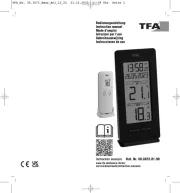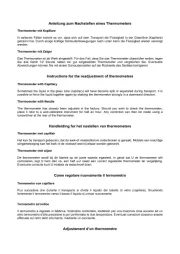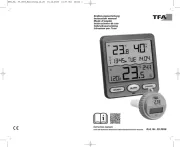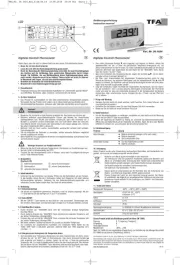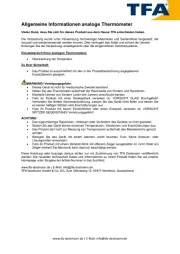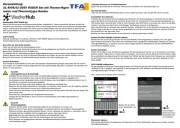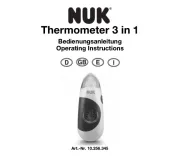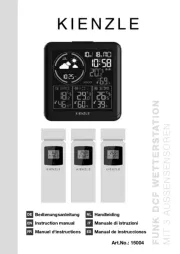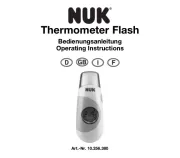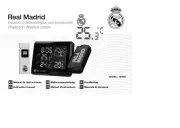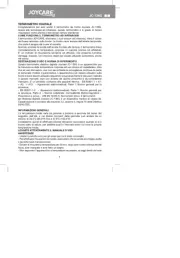
Digitales Einstichthermometer
Vielen Dank, dass Sie sich für dieses Produkt aus dem Hause TFA entschieden haben.
1. Bevor Sie mit dem Gerät arbeiten
•Lesen Sie sich bitte die Bedienungsanleitung genau durch.
•Durch die Beachtung der Bedienungsanleitung vermeiden Sie auch Beschädigungen des Gerätes
und die Gefährdung Ihrer gesetzlichen Mängelrechte durch Fehlgebrauch.
•Für Schäden, die aus Nichtbeachtung dieser Bedienungsanleitung verursacht werden, überneh-
men wir keine Haftung. Ebenso haften wir nicht für inkorrekte Messwerte und Folgen, die sich
aus solchen ergeben können.
•Beachten Sie besonders die Sicherheitshinweise!
•Bewahren Sie diese Anleitung gut auf!
2. Einsatzbereich und alle Vorteile Ihres neuen Gerätes auf einen Blick
• Temperaturmessung von flüssigen, pastösen und halbfesten Objekten für Haushalt, Beruf und
Hobby, auch für Lebensmittel gemäß HACCP
• Spritzwassergeschützt IP55
• Das Produkt ist ausschließlich für den oben beschriebenen Einsatzbereich geeignet. Verwenden Sie
das Produkt nicht anders, als in dieser Anleitung beschrieben wird.
• Das eigenmächtige Reparieren, Umbauen oder Verändern des Gerätes ist nicht gestattet.
• Dieses Gerät ist nicht für medizinische Zwecke bestimmt.
• Vorsicht beim Umgang mit der Einstichsonde. Immer mit der Schutzkappe aufbewahren!
• Halten Sie das Gerät und die Batterie außerhalb der Reichweite von Kindern.
• Kleinteile können von Kindern (unter drei Jahren) verschluckt werden.
• Batterien enthalten gesundheitsschädliche Säuren und können bei Verschlucken lebensgefährlich
sein. Wurde eine Batterie verschluckt, kann dies innerhalb von 2 Stunden zu schweren inneren Ver-
ätzungen und zum Tode führen. Wenn Sie vermuten, eine Batterie könnte verschluckt oder ander-
weitig in den Körper gelangt sein, nehmen Sie sofort medizinische Hilfe in Anspruch.
• Batterien nicht ins Feuer werfen, kurzschließen, auseinandernehmen oder aufladen. Explosionsge-
• Um ein Auslaufen der Batterien zu vermeiden, sollten schwache Batterien möglichst schnell ausge-
• Sollte eine Batterie ausgelaufen sein, vermeiden Sie Kontakt mit Haut, Augen und Schleimhäuten.
Spülen Sie ggf. umgehend die betroffenen Stellen mit Wasser und suchen Sie einen Arzt auf.
Wichtige Hinweise zur Produktsicherheit!
• Setzen Sie das Gerät nicht extremen Temperaturen, Vibrationen und Erschütterungen aus.
• Nur der Fühler ist hitzebeständig bis 300°C.
• Halten Sie niemals den Fühler direkt über Feuer.
• Tauchen Sie das Anzeigeelement nicht in Wasser, sonst kann Feuchtigkeit eindringen und zu Fehl-
funktionen führen. Nicht in der Spülmaschine reinigen.
• Öffnen Sie das Batteriefach, indem Sie mit Hilfe einer Münze den Batteriefachdeckel in Pfeilrichtung
drehen (OPEN) und entfernen Sie den Batterieunterbrechungsstreifen. Schließen Sie den Deckel
• Entfernen Sie die Schutzfolie vom Display.
• Drücken Sie die ON/OFF Taste.
• Alle Segmente werden kurz angezeigt.
• Das Gerät ist jetzt betriebsbereit.
• Das Display zeigt Ihnen die aktuelle Temperatur an.
• Der Sensor befindet sich in der Sondenspitze. Stecken Sie den Fühler mindestens 2 cm tief in das
• Um das Gerät auszuschalten, drücken Sie die ON/OFF Taste.
• Bei Nichtbenutzung schaltet sich das Gerät nach 45 Minuten aus.
• Ziehen Sie die Schutzkappe über die Einstichsonde
• Reinigen Sie das Gerät mit einem weichen, leicht feuchten Tuch. Keine Scheuer- oder Lösungsmit-
• Entfernen Sie die Batterie, wenn Sie das Gerät längere Zeit nicht verwenden.
• Bewahren Sie Ihr Gerät an einem trockenen Platz auf.
• Ziehen Sie eine Kordel durch die Befestigungsöse am Gerät und verknoten Sie sie.
• Öffnen Sie das Batteriefach, indem Sie mit Hilfe einer Münze den Batteriefachdeckel in Pfeilrichtung
drehen (OPEN) und legen Sie eine neue Batterie (LR44) ein (+Pol nach oben).
Digital Probe Thermometer
Thank you for choosing this instrument from TFA.
1. Before you use this product
•Please make sure you read the instruction manual carefully.
•Following and respecting the instructions in your manual will prevent damage to your instru-
ment and loss of your statutory rights arising from defects due to incorrect use.
•We shall not be liable for any damage occurring as a result of non-following of these instruc-
tions. Likewise, we take no responsibility for any incorrect readings or for any consequences
•Please pay particular attention to the safety notices!
•Please keep this instruction manual safe for future reference.
2. Field of operation and all of the benefits of your new instrument at a glance
• Temperature measuring of liquids, pastes and semi-solid materials for household, business and
hobby, also for food checks (according to HACCP)
• The product is exclusively intended for the field of application described above. It should only be
used as described within these instructions.
• Unauthorised repairs, modifications or changes to the product are prohibited.
• The product is not be used for medical purpose.
• Be careful by handling with the probe. If you do not use the instrument, please use always the pro-
tective cap on the probe.
• Keep this device and the battery out of reach of children.
• Small parts can be swallowed by children (under three years old).
• Batteries contain harmful acids and may be hazardous if swallowed. If a battery is swallowed, this
can lead to serious internal burns and death within two hours. If you suspect a battery could have
been swallowed or otherwise caught in the body, seek medical help immediately.
• Batteries must not be thrown into a fire, short-circuited, taken apart or recharged. Risk of explo-
• Low batteries should be changed as soon as possible to prevent damage caused by leaking.
• Avoid contact with skin, eyes and mucous membranes when handling leaking batteries. In case of
contact, immediately rinse the affected areas with water and consult a doctor.
Important information on product safety!
• Do not expose the device to extreme temperatures, vibrations or shocks.
• Only the probe is heat resistant until 300 °C.
• Never put the probe directly over fire.
• Do not immerse the display device into water. Water can penetrate and cause malfunction. Not suit-
• Open the battery compartment by turning the lid in direction of the arrow by using a coin (OPEN)
and remove the insulation strip. Close the battery compartment again.
• Pull off the protection foil on the display.
• All LCD segments will light up for about a few seconds.
• The unit is ready for use.
• The actual temperature is shown on the display.
• The sensor is located in the point of the probe. To measure the temperature, insert the probe at
least 2 cm in the object.
• Press ON/OFF button to switch off the instrument.
• When the instrument is not used, it will automatically switch off after 45 minutes.
• Put the protective cap over the probe.
• Clean it with a soft damp cloth. Do not use solvents or scouring agents.
• Remove the battery, if you do not use the product for a long period of time.
• Keep the instrument in a dry place.
• Pull a rope through the eyelet on the instrument and then knot them together.
• Open the battery compartment by turning the lid in direction of the arrow by using a coin (OPEN)
and insert a new battery LR 44 (+ pole above).
• Pay attention to the sealing ring.
• Close the battery compartment by turning the lid counter-clockwise using a coin (CLOSE).
Digitales Einstichthermometer
• Achten Sie dabei auf den Dichtungsring.
• Schließen Sie das Batteriefach wieder, indem Sie mit Hilfe einer Münze den Batteriefachdeckel in
Pfeilrichtung drehen (CLOSE).
Keine Anzeige Batterie polrichtig einlegen (+ Pol nach oben)➜
Unkorrekte Anzeige Sitz des Messfühlers prüfen➜
Wenn Ihr Gerät trotz dieser Maßnahmen immer noch nicht funktioniert, wenden Sie sich an den Händ-
ler, bei dem Sie das Produkt gekauft haben.
Dieses Produkt und die Verpackung wurden unter Verwendung hochwertiger Materialien und Bestand-
teile hergestellt, die recycelt und wiederverwendet werden können. Dies verringert den Abfall und
Entsorgen Sie die Verpackung umweltgerecht über die eingerichteten Sammelsysteme.
Entsorgung des Elektrogeräts
Entnehmen Sie nicht festverbaute Batterien und Akkus aus dem Gerät und entsorgen Sie
Dieses Gerät ist entsprechend der EU-Richtlinie über die Entsorgung von Elektro- und
Elektronik-Altgeräten (WEEE) gekennzeichnet.
Dieses Produkt darf nicht mit dem Hausmüll entsorgt werden. Der Nutzer ist verpflichtet,
das Altgerät zur umweltgerechten Entsorgung bei einer ausgewiesenen Annahmestelle
für die Entsorgung von Elektro- und Elektronikgeräten abzugeben. Die Rückgabe ist
unentgeltlich. Beachten Sie die aktuell geltenden Vorschriften!
Batterien und Akkus dürfen keinesfalls in den Hausmüll. Sie enthalten Schadstoffe wie
Schwermetalle, die bei unsachgemäßer Entsorgung der Umwelt und der Gesundheit
Schaden zufügen können und wertvolle Rohstoffe wie Eisen, Zink, Mangan oder Nickel,
die wiedergewonnen werden können.
Als Verbraucher sind Sie gesetzlich verpflichtet, gebrauchte Batterien und Akkus zur
umweltgerechten Entsorgung beim Handel oder entsprechenden Sammelstellen gemäß
nationalen oder lokalen Bestimmungen abzugeben. Die Rückgabe ist unentgeltlich.
Adressen geeigneter Sammelstellen können Sie von Ihrer Stadt- oder Kommunalverwal-
Die Bezeichnungen für enthaltene Schwermetalle sind:
Cd=Cadmium, Hg=Quecksilber, Pb=Blei.
Reduzieren Sie die Entstehung von Abfällen aus Batterien, indem Sie Batterien mit länge-
rer Lebensdauer oder geeignete wiederaufladbare Akkus nutzen. Vermeiden Sie die Ver-
müllung der Umwelt und lassen Sie Batterien oder batteriehaltige Elektro- und Elektro-
nikgeräte nicht achtlos liegen. Die getrennte Sammlung und Verwertung von Batterien
und Akkus leisten einen wichtigen Beitrag zur Entlastung der Umwelt und Vermeidung
von Gefahren für die Gesundheit.
Umwelt- und Gesundheitsschäden durch falsche Entsorgung der Batterien!
Messbereich Temperatur: -50 °C… 300 °C
Genauigkeit: ±1°C @ -10…+100 °C
±2°C @ -50..-10°C / >100…+200°C
Arbeitsbereich: -5 °C…+50 °C
Batterie: 1x LR44 Knopfzell-Batterie (inklusive)
Hersteller Gan Cun Section, Fo Chen Road, Chen Cun County,
Shun De District, Fo Shan City, Guang Dong Province,
Gewicht: 27,7 g (inkl. Batterie und Schutzhülle)
TFA_No_30.1048_Anl_03_25 28.03.2025 11:00 Uhr Seite 1


